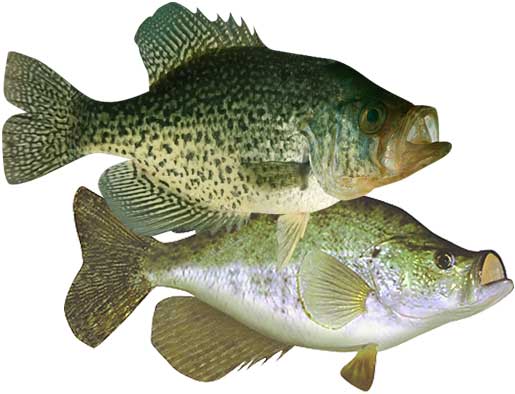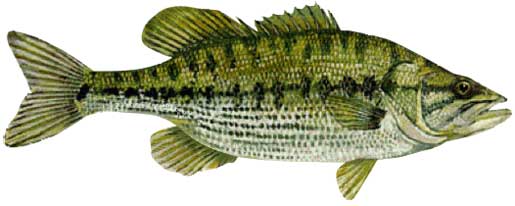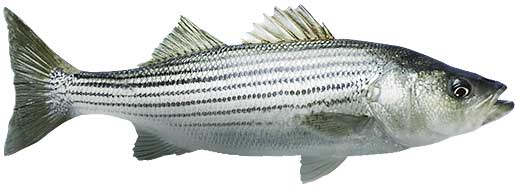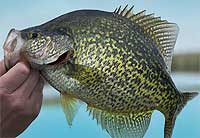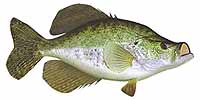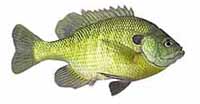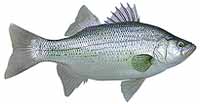Fishing Report For W Kerr Scott Reservoir, NC
By Rick Seaman
Last updated on .
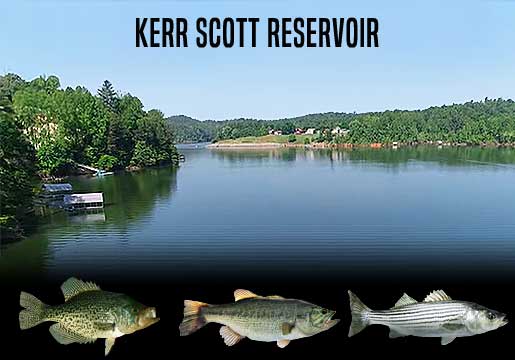
Fishing Reports
Popular Fish Species Kerr Scott Lake, NC
Black & White Crappie
Current Report: Good
Crappie fishing in W Kerr Scott Reservoir is reported to be better in the last couple years, and shows signs of continuing this year.
FALL. Baitfish, which are moving into shallow flats, coves and bays, are drawing crappie into these areas. They are feeding heavily in preparation for the cold Winter, in 8 to 12 feet of water. Minnows, hair jigs, and crappie jigs, are good options during this feeding marathon. Late fall starts the migration deeper, toward winter holding areas, for both crappie and baitfish. Small flutter spoons, fished in 15 to 20 feet of water, are a good option during this transition. Good results are coming around points, creek channels, and brush piles.
WINTER. Once the shallows start cooling rapidly, crappie will migrate to deeper holding areas, mostly off shore. At this time they are typically caught using a very slow presentation, in 15 to 25 feet of water. Most are caught around deep brush piles, creek channel bends, submerged timber, and main-lake structure. If they are suspending in open water, they often relate to some cover, or structure change, directly below them. During warming trends, especially warm afternoons, they are often drawn into 8 to 15 feet of water to feed.
SPRING. In early Spring, crappie begin staging in 8 to 12 feet of water, just outside spawning bays and shallow flats. The major creek arms of Warrior Creek, Marley Ford Creek, Whites Creek and Smithey's Creek are areas that crappie like to hold. Spring is prime time to be on the water, as both black crappie and white crappie have moved shallow to spawn. At that time, they are typically caught in 4 to 8 feet of water. Vegetation, docks, brush and wood are where most anglers catch crappie using small crappie jigs or live minnows. After the spawn, crappie typically move outside the spawning area and hold on cover close by, in 10 to 12 feet of water. Once they move deep, anglers report success using fish finders and forward facing sonar to locate schools of crappie, which tend to stack vertically around cover. Light tackle, with 4 lb to 8 lb line, is a popular choice.
SUMMER. Water temperatures get quite warm, and crappie fishing is usually pretty good. They feed in 8 to 15 feet of water early and late in the day, until the hot Summer sun causes them to retreat to depths of 10 to 20 feet. Also, a few have embedded in the shade of slightly shallower vegetation. This is a good time to focus around brush piles, standing timber, deep lay downs, bridge pilings and deeper docks. Anglers are also locating schools of crappie hanging over deep structure and around creek channel edges, using fish-finder electronics.
Spotted Bass
Current Report: Good To Very Good
W Kerr Scott Reservoir Lake is widely-known as an exceptional spotted bass fishery. Largemouth and smallmouth also reside here, but the spots are the preponderance of bass to catch.
FALL. Locals report that Fall is the best time to catch spotted bass here, as they prefer the cooler water and move a bit shallower. Tube jigs on light line is a good tactic on steeper banks, points and along ledge drop-offs. As Fall cools the shallows, spotted bass here follow schools of baitfish into coves and bays, where spoons, and slow-rolled spinnerbaits, are successful.
WINTER. Winter will draw them in large groups, around deeper structure, points and creek channels - anywhere there is baitfish. They can be found from 10 to 20 feet deep, holding on steep walls of drop offs, in Winter. Here they hold, feeding less aggressively, waiting warmer water to return in Spring.
SPRING. With water temperatures in the in the low 60's now, spotted bass have moved from deep wintering areas to depths of 4 to 12 feet, just outside spawning bays and coves. They are getting focused on the spawn. Once water warms into the high 60's, they move into even shallower water, and create nests, then lay their eggs. Immediately upon spawning, females move to deeper water around 15 feet deep. Males remain to guard the eggs, and then the fry. After a couple weeks, the males join the females. Deep crankbaits, spinnerbaits, small jigs, plastic worms and swimbaits are now catching plenty of spotted bass.
SUMMER. Spots are being caught on steep, rocky banks, ledges, humps, drop-offs and standing timber, in 8 to 18 feet of water, sometimes even deeper. At night they often venture shallower to feed. They tend to gather in small schools and hold, preferring to move up and down the water column on steep banks looking for food and ideal water temperatures. They are occasionally feeding shallow, early and late in the day, where they are being caught on topwater, crankbaits and swimbaits. Drop-shots, Ned rigs, and wacky-rigged stick worms are catching finicky bass when they are deeper. They feed here on shad, small sunfish and crawfish. During the hotter parts of the day, they are being caught on points and ledges 18 to 25 feet deep. Spots will also hold in the shade of heavy, shallower vegetation.
Striped Bass
Current Report: Good To Very Good
Stripers tend to remain in the main body of the lake, around river channels and ledges dropping into deep water. The best reports tend to come between the W Kerr Scott Dam and the Lewis Fork area.
FALL. In Fall, stripers return to shallower water. Early in the day stripers chase bait to the surface and feed aggressively, making this an excellent time for topwater action. They follow schools of bait, which are hanging out in 10 to 25 feet of water. Look for shallow water nearby deeper river channels, and fish them thoroughly. Most any lure that resembles shad will catch striped bass at this time of year.
WINTER. In Winter, stripers again hang out in deeper water and feed close to the bottom, often as deep as 35 feet. Warm, sunny afternoons occasionally draw stripers shallower, to around 10 or 20 feet deep as they feed on roaming schools of shad. The main lake basin, along deep channels is holding schools of stripers, especially in the section of lake around the dam. Locate schools of bait, then look for stripers close by. Fish finders, and forward facing sonar, are a big help in locating these roaming schools. Nice stripers are caught while drift fishing with live bait or cut bait. Spoons, blade baits, and heavy hair jigs are also effective this time of year. Due to the stripers slower metabolism this time of year, anglers are triggering more strikes by working baits more slowly.
SPRING. Water temperatures are return to the mid 60's, and that's ideal for the stripers to spawn. In Spring, work the upper end of the lake, and the backs of coves, where there is inflowing water. If they spawn, this is where they will lay eggs in the moving water. They also move into transition zones on the main lake, in 10 to 20 feet of water, feeding on baitfish which are moving toward the shallows. Expect to locate them on mid-depth ledges, flats or points.
SUMMER. Summer months are the ideal time to chase striped bass here. These stripers hang out in deeper water during the heat of the day, 15 to 30 feet deep, early in the season. Much of the time they are holding over deeper, open water. Morning often draws the stripers shallower, so look for them around the 10-foot range as they feed on roaming schools of baitfish. Being successful at fishing for stripers in Summer is a matter of locating schools of bait, and the wolf packs of stripers are likely to be nearby. Later in Fall, expect to locate schools 20 to 35 feet deep. Fish finders, and sonar electronics, are a big help in locating these roaming schools. Nice stripers are being caught while trolling or drift fishing. Spoons, blade baits, crankbaits, live bait and cut bait are all effective here.
Fishing Video
Fish species to fish for...
Guide to fishing for largemouth bass, smallmouth bass, spotted bass, channel catfish, blue catfish, black crappie, white crappie, bluegill, white bass, striped bass and tiger muskie at W Kerr Scott Reservoir in North Carolina.
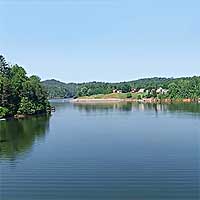 Kerr Scott Reservoir is a 1,475-acre lake, with over 50 miles of shoreline, is located in the north-central part of the state. Largemouth, smallmouth and spotted bass, striped bass, crappie, catfish and tiger muskie are the main fish species targeted by anglers here.
Kerr Scott Reservoir is a 1,475-acre lake, with over 50 miles of shoreline, is located in the north-central part of the state. Largemouth, smallmouth and spotted bass, striped bass, crappie, catfish and tiger muskie are the main fish species targeted by anglers here.
Primary fish species to catch
Click images for fishing tips and details about each species.
Today's Weather & Forecast
Public Boat Launch Ramps & Landings
Click here for boat ramps.
Fishing License
Click here for a North Carolina Fishing License.
Map - Fishing & Access
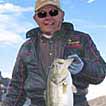 Rick Seaman is a fishing enthusiast with over five decades of fishing experience, a retired tournament fisherman, author of numerous published articles on fishing, and co-author of the book "Bass Fishing - It's not WHAT you throw, It's WHERE you throw it".
Rick Seaman is a fishing enthusiast with over five decades of fishing experience, a retired tournament fisherman, author of numerous published articles on fishing, and co-author of the book "Bass Fishing - It's not WHAT you throw, It's WHERE you throw it".
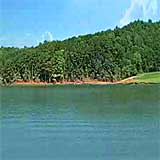 Contact Information
Contact Information
Skyline Marina
4008 NC-268
Wilkesboro, NC 28697
336 921-3783
Fishing lakes in each state
102125
Kerr Scott Reservoir, NC Report
NORTH CAROLINA


Bass, stripers and tiger muskie fishing in north-central NC.


